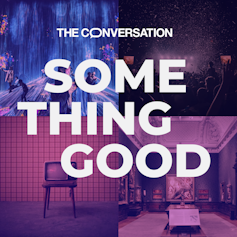Studio Ghibli films are often put into the rather vague category of “Japanese animation”. Many viewers expect the studio’s films to be rooted in the culture and stories of it’s home nation, Japan. This makes its foray into adapting western stories all the more intriguing.
Studio Ghibli has been critically lauded since 1985, with the release of its debut feature Laputa: Castle in the Sky. The studio later gained international reverence following the releases of Princess Mononoke (1997) and, more significantly, Spirited Away (2001), which won the Academy Award for best animated feature.
Both the studio’s founders have long-standing interests in adapting western stories. Hayao Miyazaki was member of the children’s literature club at Gakushūin University, which often discussed English works. And Isao Takahata directed one of the first World Masterpiece Theater series of European-inspired anime TV shows in the 1970s.
Their early films with Studio Ghibli were only aesthetically inspired by western art and architecture. In terms of story, they were typically based on Japanese tales or manga. Kiki’s Delivery Service (1985), for example, is set in a European metropolis but was originally a novel by Japanese author Eiko Kadono.
Western inspiration
This changed with the release of Howl’s Moving Castle (2004), directed by Miyazaki. It was the first of Studio Ghibli’s adaptations to take its plot directly from a European story – British author Diana Wynne Jones’ novel of the same name from 1986.
The work of Wynne Jones (who later revealed herself to be an admirer of Miyazaki) shares many themes with Studio Ghibli films. This includes uniquely fantastical environments and situations, unexpected inversions of genre norms and determined female protagonists who possess as much agency, if not more, than any of the men surrounding them.
However, this doesn’t mean that her original story was left untouched. Miyazaki’s interpretation inserts a war plot that wasn’t present in the source novel’s story of body swapping and sisterhood, intended as a protest against the Iraq war.
This example reveals an interesting element of Ghibli’s adaptations – that the source material serves as an artistic jumping off point for the directors to use in their own creative processes.
Despite this lack of narrative fidelity – or maybe because of it – Howl’s Moving Castle is now one of the studio’s most beloved films.
Tales from Earthsea (2006), in contrast, is one of the studio’s less successful works. The film was inspired by the Earthsea Cycle series of novels by American author, Ursula K. Le Guin. When asked by the film’s director what she thought about the film, Le Guin coolly replied: “It is not my book. It is your movie.”
This is perhaps due to the filmmaker behind Earthsea being Goro Miyazaki, the inexperienced son of Hayao Miyazaki who was being positioned as a potential heir to the Ghibli throne. His lack of animation knowledge when compared to his peers may have contributed to the slow plot and simplistic morality that plague the film – though there’s still much to appreciate in its artistry.
For the next Ghibli release, Hayao Miyazaki was once again brought on to create a western-inspired animation. Ponyo (2008) is a version of The Little Mermaid so radically different that it’s almost unrecognisable from its source material.
Instead of a beautiful teenager longing for romance on land, the film follows a brilliantly wild toddler and how her free spirit carries her beyond the sea, falling for fellow tot Sōsuke in the process. In feminist terms, the text is totally reframed, transformed from patriarchal morality tale to a story that prioritises the joys of love and childhood, beyond gender roles.
International success
Ghibli has continued down the path of creating adaptations of western stories. Director Hiromasa Yonebayashi – groomed to be Miyazaki’s successor – has produced several. These include Arrietty (2010) and When Marnie Was There (2014), both based on classic British children’s novels from the mid-20th century.
As well as giving a recognisable foundation for western audience members, these stories allow for beautiful explorations of the British countryside and the female-focused approach that Ghibli has become known for.
Ghibli animations like these have become not only a significant element of the studio’s branding, but of its enormous international success. Films like Spirited Away (2001) and Princess Mononoke (1997) that lean more into Japanese aesthetics, histories and stories are arguably more widely known, but they make up a surprisingly small portion of the studio’s filmography.
These “European palimpsests” (as anime studies scholar Rayna Denison aptly deems them) have become Ghibli’s bread and butter in the latter years of the studio’s life. Beyond the obvious level of quality and artistic merit in their films, this may go some way to explain Ghibli’s enduring global popularity. The studio layers Japanese and western storytelling and aesthetics into a complex web that can be near universally enjoyed.

Looking for something good? Cut through the noise with a carefully curated selection of the latest releases, live events and exhibitions, straight to your inbox every fortnight, on Fridays. Sign up here.
Zoe Crombie does not work for, consult, own shares in or receive funding from any company or organisation that would benefit from this article, and has disclosed no relevant affiliations beyond their academic appointment.
This article was originally published on The Conversation. Read the original article.







